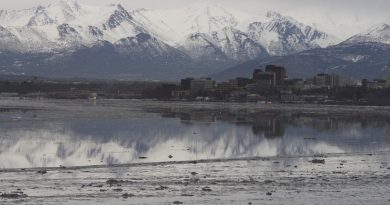Blog: Narva, Estonia—A would-be Arctic crossroads on Europe’s edge
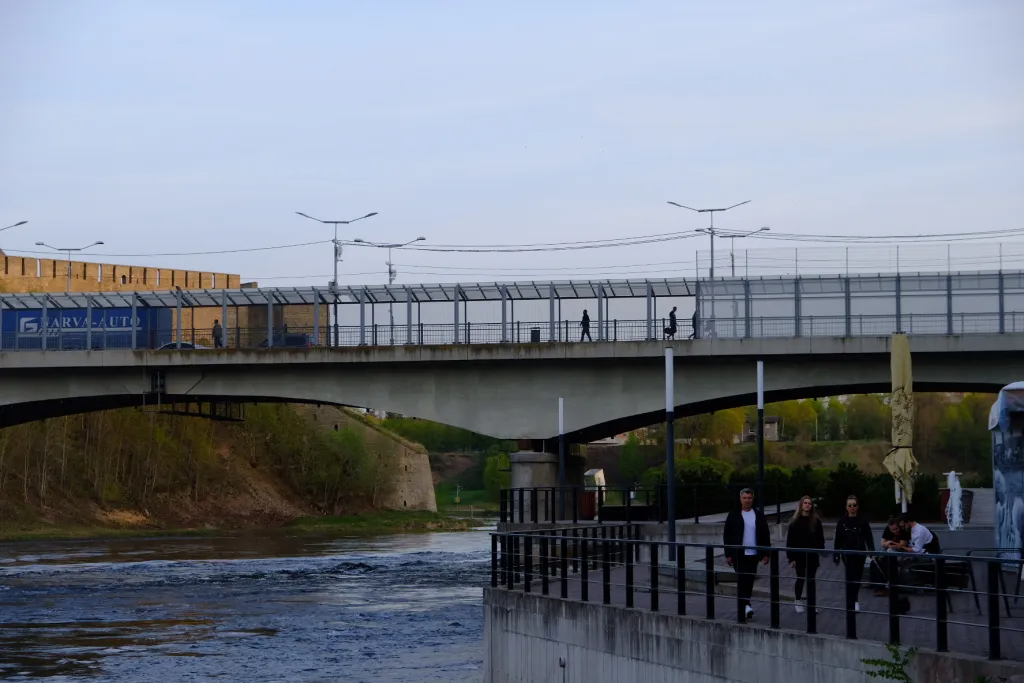
The story of Narva is the story of the Arctic port that never was. Had it taken off as an entrepôt, it might have given rise to a different conceptualization of the High North region – perhaps one centered on the Baltic, Barents, and White Seas rather than the Arctic Ocean.
On Estonia’s eastern edge sits the European Union’s “Russian City”: Narva. 97% of the residents in the third-largest metropolis in the Baltic country speak Russian. The ethnic enclave, whose population of 57,000 is nearly identical to Greenland’s, is the outcome of a Soviet post-war policy. In a form of ethnic cleansing, the Politburo forbade Narva’s original residents from returning. To replace the lost residents and provide employees for one of the world’s largest cotton mills and a planned uranium processing plant (the latter which was eventually built elsewhere in Estonia), the Soviet Union imported Russian speakers from across the Soviet Union. Their descendants populate the city to this day.
Narva is one of the few remaining open crossroads between the EU and Russia. When I visited last week, I was astonished to see trucks, vehicles, and people on foot going back and forth daily. Having heard of border closures between Russia and its Nordic neighbors, Finland and Norway, I had thought the Estonian border would be a ghost town, too. But that was not the case – at least not for now. (The Russian government has announced that it may close the crossing for ostensible repair works sometime this year.)
Narva remains one of the most important points for trade between the European Union and its eastern antagonist. Yet 500 years ago, the city nearly became an Arctic crossroads.
Narva’s nearly northern history
At the intersection of a river that flows into the Baltic Sea and multiple trade routes radiating east, Narva has long held economic promise – perhaps too much for its own good. The city’s strategic allure has led it to be sold, bisected, conquered, and destroyed numerous times since humans began inhabiting the area in the 5th millennium BC.
The two castles glowering at each other across the river were forged out of centuries of conflict between Russia, which has with some minor exceptions held the eastern banks, and the rulers of the western banks. Less consistent, these powers have represented a patchwork of Danish, Livonian, Russian, Swedish, and now Estonian rulers. At one point under Estonian rule in the twentieth century, the eastern banks fell under Estonian rule, leading the settlement there, Ivanogorod, to become a suburb of Narva. But once the Soviets occupied Narva during World War II, after the war, they cut off Ivanogorod and made it a separate town.
Last week, I stood on Narva’s waterfront gazing at Russians going for their evening strolls just a few hundred meters across the river in Ivanogorod. Birds flew back and forth between the two banks, unperturbed by the breakdown in bilateral relations. The two castles were illuminated by the same setting sun. But on the Estonian one, a huge poster that read “PUTIN: WAR CRIMINAL” had been unfurled, while a Russian tricolor breezed proudly atop a tower on the opposite side. Several houses facing the river had draped big Russian flags over their balconies, too.

On the Estonian side, a man cast his line for fish in the river Narva, which courses downward from an upstream dam now bisected by an international border. The river channels into a Russian hydropower plant, which thrummed behind him. It was originally built in the 1950s at a time when both Narva and Ivanogorod both belonged to the same country: the Soviet Union. Now, as I ambled on the Estonian banks of the Narva river, the socialist empire’s crumbling remains were the only thing standing between the Pacific Ocean and me.
Russia was also the last country en route to the Arctic Ocean. If history had taken an alternate route, Narva could have become a hub for northern commodities.
An Englishman in Arkhangelsk: The origins of the Muscovy Company
In 1555, following English sailors’ efforts to find a northeast passage to China, the crown granted one of the world’s first joint-stock companies an exclusive charter to trade with Russia. With a reciprocal monopoly on trade with England granted by Ivan IV (Ivan the Terrible), the Muscovy Company constructed warehouses in Kholmogory (“a great mart for the northern districts of Russia…where Lapps, Samoyedes, Karelians, Russians and Tatars came there to trade in fish, oil, and furs”), Vologda, and Moscow.
With Russia conquering increasing stretches of Siberia throughout the fifteenth and sixteenth century, more furs were accumulated as conquered ethnic groups were forced to pay tribute in pelts, a practice known as yasak. Hunters from the White Sea region, known as Pomorye, also travelled to Siberia to trap furs. Records suggest that up to 2,000 Russian trappers moved into Siberia each year, a region whose entire population was probably only around 227,000 in the 1600s. Furs were loaded onto English vessels, which sailed down the Northern Dvina River, into the White Sea, and around the rocky coast of Norway all the way to London. In exchange, Russia received Western goods and bullion, including silver from the New World.
In England’s capital, Siberian furs adorned the bodies of nobles and the upper class. The centuries-old association between the snow-white fur of the ermine and purity persists, as illustrated by the extravagant ermine-trimmed robe King Charles wore at his coronation just this month, in May 2023. (The ermine fur on his reused robe was sourced from Canada.) Arctic creatures began appearing in sixteenth-century English popular culture, too, with William Shakespeare throwing a polar bear into A Winter’s Tale.
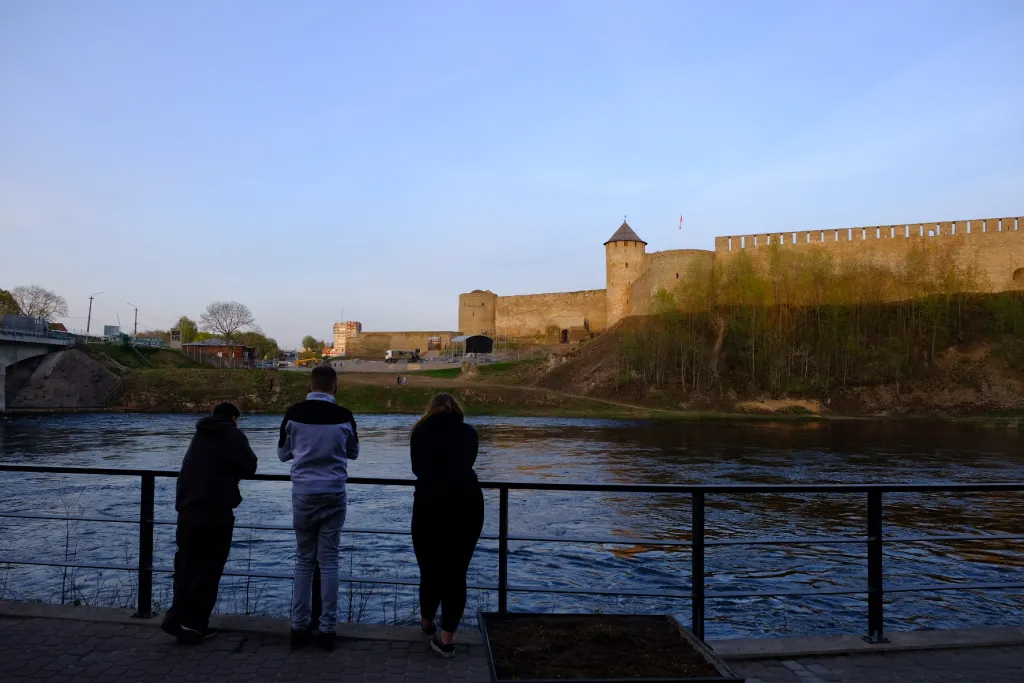
As Todd Borlik writes in a fascinating new chapter touching on the English playwright, ermines, and the White Sea fur trade, as the Muscovy Company repeated the profits of trade with northwest Russia, “Shakespeare’s contemporaries were beginning to view the Arctic not as an icy wasteland or abode of fabulous monsters but as a wilderness abounding in natural resources, including whale oil, walrus ivory, and animal fur.” In return, Siberia – fully conquered by the Tsardom of Russia in 1580 – and the Arctic were growing in importance to Russia as a resource base, which remains the case 500 years later.
Hooked on furs, English merchants wanted to stockpile even more. Narva, which Russia had wrested from the Livonian Order in 1558, provided one possibility for ramping up the fur trade now that the expanding country had an outlet on the Baltic Sea. Further rationale for routing exchange via Narva was that English ships could sail via the Baltic three times a year instead of just once via the Norwegian cape. Arkhangelsk was locked in by ice eight to nine months a year. The voyage to the Russian port city from England took a treacherous four to six weeks, “with only the hardest biscuit and the saltest of meat as victuals, with the wild and desolate shores of Norway and Lapland under their lea, and buffeted by the monstrous waves of the northern seas, which were still full of ice,” as one scholar described in 1920. Narva also offered the potential to deal in silks and other commodities from Persia, which Armenian traders in the city sourced from the Caspian Sea trade.
Yet Arkhangelsk managed to hold on to its position as the hub for Arctic trade, and Narva never turned to the north. The Baltic city’s fall from Russia to Sweden in 1581 dealt another blow to hopes to turn the city into a northern trading emporium. Sable, mink, ermine, squirrel, and other pelts from the Siberian tundra continued to be traded through Arkhangelsk, where Dutch sailors were increasingly present while English merchants began turning westward towards the Atlantic in search of fortune.
As late as 1655, English officials once again considered funneling their lucrative fur trade with northern Russia through Narva instead of Arkhangelsk. But this still did not come to pass. In fact, Arkhangelsk remained the sole seaport from goods from the Russian interior until 1721. That year, after defeating Sweden in the Great Northern War, Russia finally regained a foothold on the Baltic Sea, where Peter the Great would construct the port city of St. Petersburg.
While Narva might never have looked north, the borderland city has managed to remain a place of exchange between Russia and the West – even now, after the invasion of Ukraine and the breakdown in relations.
Narva today: Estonia’s Siberia?
Last week, two hundred kilometers to the west in the unmistakably Estonian capital of Tallinn, the country’s Minister of Defence mentioned Narva in his pre-dinner speech to participants at the Lennart Meri Conference. He made reference to Samuel P. Huntington’s geopolitical (in)explainer, The Clash of Civilizations, which claims that the division between Western and Orthodox civilizations lays on the river Narva.
“This borderline hasn’t moved for centuries, and I assure you it will not,” Hanno Pevkur proclaimed.
Yet control of Narva has changed hands countless times, including as recently as 1991, when the Estonian Soviet Socialist Republic declared independence. Walking around Narva, it is easy to mistake the western for the eastern banks. Russian is the only language heard in the streets of the Estonian city. My tiny hotel room had a framed picture of an Orthodox saint, and I had to take off my shoes and put on slippers to enter – a typically Eastern custom. Except on government buildings, no Ukrainian flags were flying. The lack of blue-and-yellow banners contrasted starkly with Tallinn, where sympathies for the invaded run deep.
One sleepy Friday morning, I crossed over the train tracks that once connected Tallinn, Narva, St. Petersburg, and Moscow. That service was suspended during the pandemic and has not since been brought back. Several freight trains sat on the rails, including one with several oil tankers marked with “Павлодар-Северны” (Northern Pavlodar). This was the stamp of the Pavlodar Oil Chemistry Refinery, one of the biggest in Kazakhstan, which processes fossil fuels from Western Siberia. Inside the rusting cylinders sitting on the train tracks, ancient fossils from the Siberian lands whose exploitation had been powering the Russian economy for half a millennium could be found.
In some ways, then, Narva did become a polar crossroads.
I crossed over the train tracks and headed south. An old opera house constructed during Stalin’s regime blazed bright white in sun-bleached abandonment. The only telltale sign that the building was in Estonia and not Russia was the teal-green Bolt scooter, a marker of 21st-century mobility which has become ubiquitous across the forward-looking Baltic country.
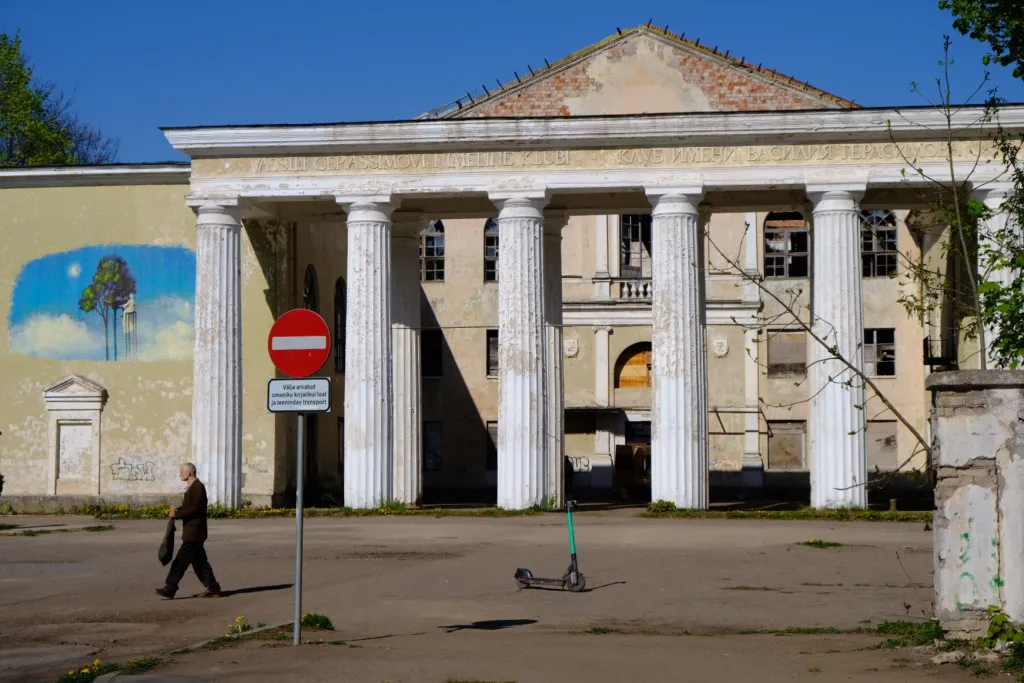
A few hundred meters from the faded opera house, dozens of bouquets had begun to wilt in the premature summer heat at a memorial to the “Great Patriotic War” (World War II). The floral sacrifice had likely been laid a few days before on Russia’s Victory Day (8 May) – the day Vladimir Putin proclaimed in Moscow that “a real war has been unleashed against our Motherland.”
Nearby, a massive industrial building stretched for blocks. A few government-printed signs tacked onto it (notably in Estonian) indicated that it was being redeveloped. The site used to house the Baltijets factory, which specialized in manufacturing electronic and mechanical equipment. Right in the middle of town, the restricted-access building, which was wiped from many city maps, was originally designed for housing the development of rare earth metallurgy and uranium enrichment technology. Soviet urban planning 101.
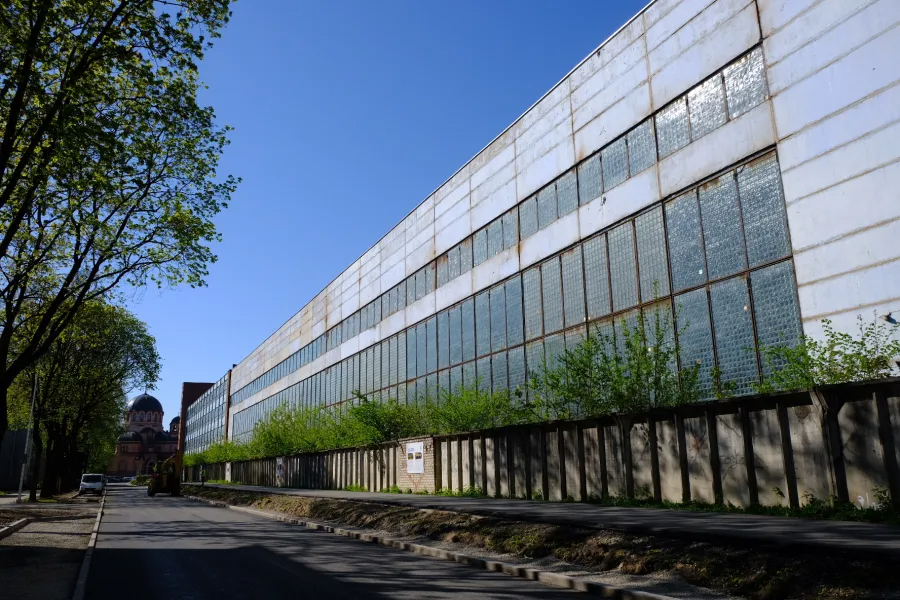
During my walk, I popped into the Lidl discount supermarket, which made for a bizarre pastiche of Euro-hypermarché meets Soviet rynok (market). As I was eying the fermented milk section, which was as full of kefir, yogurt, and ayran like any self-respecting Russian grocery store, one older gentleman asked me, in Russian, when the expiration date on a bottle of kefir was. (As anyone who has shopped in the former Soviet Union will understand, this was a perfectly normal question given that many grocery stores sell expired goods. It would have been a bit uncultured to ask that in central Tallinn’s sleek grocery stores, however.) The self-checkout lines marked “Card Payment Only” sat empty, their yearning lights flashing green. Snaking lines of cash-strapped shoppers overwhelmed the two cashiers on duty. Inside the entrance to the supermarket, a babushka sold viscous blocks of fat and mahogany sausages. In the parking lot, berries were sold just as they are on countless Russian roadsides in summer, from here to Kamchatka.
Closer to the town center, a bakery sold limp, plastic-wrapped pastries. The hodgepodge assortment hardly resembled the piping-hot glazed, sugared cardamom buns and cinnamon buns found in Tallinn’s bakeries, which take their carbohydrate cues from the trendy establishments found in Nordic capitals. They were instead more similar to something found 10,000 kilometers away in Vladivostok, attesting to the phenomenal extent of Soviet “cuisine”. Some cultures aspire to culinary refinement; others seek out culinary colonization.
While the bakery’s goods didn’t seem to have much staying power, one of the tallest buildings in Narva did. An alien concrete monolith squatted ominously atop it. I read at an exhibit in the Narva Castle that the accordion-like structure had been designed as a water tower, though was never used for that purpose. The castle exhibit included an old black-and-white photograph of the structure, when Lenin’s eternally half-smiling face graced its pleated cement. It reminded me of a hydroelectric power plant I had once visited thousands of miles away in the Sakha Republic, in deepest Siberia, where a multistory Lenin still strides proudly along a building wall.
Across the country, the Estonian government has tried to scrub obvious traces of the five-decade Soviet occupation. Removals of memorials to the Great Patriotic War, which provoked Russia’s cyberattacks on the country in 2007, are the most notable example. Yet signs of the Soviet past are there if you look for them, just as signs of the phantom Arctic are, too. Perhaps it is no small irony that one worker at the Baltijets factory, lamenting the inability to obtain Estonian-language teachers for their schoolchildren, described Narva in 1992 as “the Siberia for the Estonian professorate.” Narva lies at the edge of both the Estonian and Russian worlds, making it a complex zone of encounter rather than a hard-and-fast line between oppositional civilizations.
The longue durée of Arctic world history
The story of Narva is the story of the Arctic port that never was. Had it taken off as an entrepôt, it might have given rise to a different conceptualization of the High North – perhaps one centered on the Baltic, Barents, and White Seas rather than the Arctic Ocean. A map I came across of “Barents Sea area trade” in an article published in the scientific journal Arctic offers a sense of a different northern geography.
Viewed in the longer sweep of time, northern trade forms an integral part of a global system rather than a fringe economy. Rather than globalization opening the Arctic, Arctic trade routes such as the Muscovy Company’s route from England to Russia via Norway’s north coast actually pushed forward globalization. Fur trappers from the White Sea region who traveled from north to south played an instrumental role in Siberia’s exploitation, too.
Inverting the Arctic’s position by moving it from a peripheral to a central role in world history makes it obvious how much of Eurasia, from London to Beijing, has been clamoring for Russian commodities for centuries. This drive has led foreigners to seek ways to access these precious goods, whether via ports like Narva and Arkhangelsk or pipelines like the ill-fated Nord Stream 1 and 2, while compelling Russia to dial up its resource extraction. As historian John F. Richard writes in The World Hunt, “The tsars, heads of a centralizing and aggrandizing regime, maintained continuity of purpose from reign to reign. In large measure, Moscow’s determination can be explained by the fact that the world fur market continued to send out strong demand signals.”
As Russia conquered more swathes of land over the centuries, it plundered Siberian resources. Furs, oil, and minerals have all transformed Siberia into a global sacrifice zone, with animals, Indigenous Peoples, and ecosystems all suffering. The profits from this plunder have enriched an elite few and financed further state violence both domestically and extraterritorially, as the war in Ukraine brutally evinces. But the global community bears responsibility for feeding the monster, too.
At the same time, Russian leaders have long struggled to hold onto newly acquired lands and get their commodities to market. The country’s newfound isolation by the West and the cratering of the number of foreign vessels using the Northern Sea Route bespeak yet another reconfiguration of relations in the White Sea where English traders first stumbled ashore in 1553 – “the year England discovered Russia,” as one scholar wrote.
470 years later, the West is trying hard to undiscover it.
This post first appeared on Cryopolitics, an Arctic News and Analysis blog.
Related stories from around the North:
Norway: And in Between, There Are Doors’—Europe, the Arctic, and shared spaces, Blog by Marc Lanteigne



